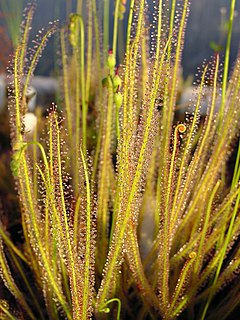
Cyperus papyrus, better known by the common names papyrus, papyrus sedge, paper reed, Indian matting plant, or Nile grass, is a species of aquatic flowering plant belonging to the sedge family Cyperaceae. It is a tender herbaceous perennial, native to Africa, and forms tall stands of reed-like swamp vegetation in shallow water.

Cyperus is a large genus of about 700 species of sedges, distributed throughout all continents in both tropical and temperate regions.

Drosera filiformis, commonly known as the thread-leaved sundew, is a small, insectivorous, rosette-forming species of perennial herb. A species of sundew, it is unusual within its genus in that the long, erect, filiform (thread-like) leaves of this plant unroll in spirals – an arrangement similar to the circinate vernation seen in ferns.

Persoonia filiformis is a species of flowering plant in the family Proteaceae and is endemic to the south-west of Western Australia. It is a small, erect shrub with hairy young branchlets, linear leaves and greenish yellow flowers borne singly or in groups of up to twenty on a rachis up to 30 mm (1.2 in) long.

Cicendia filiformis, also called yellow centaury or slender cicendia, is a species of flowering planet of the family Gentianaceae.
Cyperus prolixus is a species of sedge that is native to southern parts of North America, Central America and tropical parts of South America.
Cyperus seslerioides is a species of sedge that is native to southern parts of North America, Central America and parts of South America.
Cyperus drummondii, commonly known as Drummond's sedge, is a species of sedge that is native to the southern parts of North America, parts of Central America, and northern parts of South America.

Cyperus hermaphroditus, commonly known as the hermaphrodite flatsedge, is a species of sedge that is native to parts of southern parts of North America, Central America and northern parts of South America.
Cyperus pallidicolor, commonly known as the pallid flatsedge, is a species of sedge that is native to southern parts of North America, parts of Central America and northern parts of South America.
Cyperus planifolius, commonly known as flatleaf flatsedge, is a species of sedge that is native to southern parts of North America, Central America, the Caribbean, and northern parts of South America.
Cyperus spectabilis is a species of sedge that is native to southern parts of North America, Central America and parts of South America.
Cyperus stergiosii is a species of sedge that is native to parts of South America.
Cyperus svensonii is a species of sedge that is native to parts of Central America and northern parts of South America.
Cyperus swartzii, commonly known as Swartz's flatsedge, is a species of sedge that is native to southern parts of North America, northern parts of South America, Central America, and the Caribbean.
Cyperus tabina is a species of sedge that is native to parts of South America.
Cyperus tatandaensis is a species of sedge that is native to parts of Africa, South America and Central America.
Cyperus tetragonus is a species of sedge that is native to southern parts of North America.





